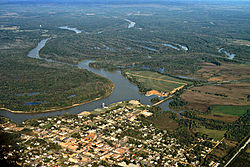Demopolis, Alabama
| Demopolis, Alabama | |
|---|---|
| City | |

Aerial view of Demopolis, Alabama. The confluence of the Tombigbee and Black Warrior Rivers is visible in the center of the picture. View is to the northwest.
|
|
 Location in Marengo County and the state of Alabama |
|
| Coordinates: 32°30′34″N 87°50′14″W / 32.50944°N 87.83722°WCoordinates: 32°30′34″N 87°50′14″W / 32.50944°N 87.83722°W | |
| Country | United States |
| State | Alabama |
| County | Marengo |
| Area | |
| • Total | 12.4 sq mi (32.3 km2) |
| • Land | 12.2 sq mi (31.7 km2) |
| • Water | 0.2 sq mi (0.6 km2) |
| Elevation | 121 ft (37 m) |
| Population (2000) | |
| • Total | 7,540 |
| • Density | 608.1/sq mi (233.4/km2) |
| Time zone | Central (CST) (UTC-6) |
| • Summer (DST) | CDT (UTC-5) |
| ZIP code | 36732 |
| Area code(s) | 334 |
| FIPS code | 01-20296 |
| GNIS feature ID | 0117222 |
| Website | demopolisal.gov |
Demopolis is the largest city in Marengo County, Alabama, United States. The population was 7,483 at the time of the 2010 United States Census.
The city lies at the confluence of the Black Warrior and Tombigbee rivers. It is situated atop a cliff composed of the Demopolis Chalk Formation, known locally as White Bluff, on the east bank of the Tombigbee River. It is at the center of Alabama's Canebrake region and is also within the Black Belt.
Demopolis was founded after the fall of Napoleon's Empire and named by a group of French expatriates, a mix of exiled Bonapartists and other French migrants who had settled in the United States after the overthrow of the colonial government in Saint-Domingue following the failed Saint-Domingue expedition. The name, meaning in Greek "the People's City" or "City of the People", was chosen to honor the democratic ideals behind the endeavor. First settled in 1817, it is one of the oldest continuous settlements in Alabama. It was incorporated on December 11, 1821.
Organizing themselves first in Philadelphia, French expatriates petitioned the U.S. Congress to sell them property for land to colonize. Congress granted approval by an act on March 3, 1817 that allowed them to buy four townships in the Alabama Territory at $2 per acre, with the provision that they cultivate grape vines and olive trees. Following advice obtained from experienced Western pioneers, they determined that Alabama would provide a good climate for cultivating these crops. By July 14, 1817, a small party of pioneers had settled at White Bluff on the Tombigbee River, at the present site of Demopolis, founding the Vine and Olive Colony.
...
Wikipedia
